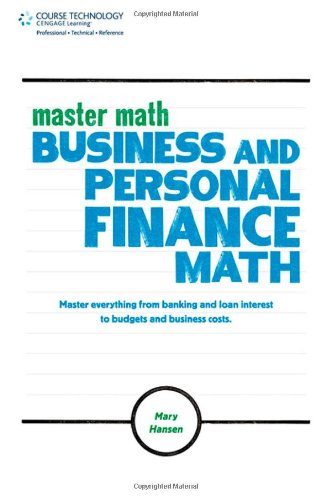I’m finishing up teaching an undergraduate course on Personal Finance this month, for which I find the assigned textbook totally useless, so I am on a quest to come up with a useful book to recommend for students as well as Bankers Anonymous readers.
What’s useful
The most impressive strength of Master Math: Business and Personal Finance Math by Mary Hansen is that it cuts out all the (mostly) banal ‘advice’ of a personal finance book, and concentrates instead on how to do the calculations. The math level never rises beyond algebra, which frankly is all anyone needs to know, in order to competently manage their personal or small business finances.
I find this a useful guide for a ‘Do-It-Yourselfer,’ or a person intent on learning exactly how car loan companies calculate APR vs. APY, or insurance companies quote term life insurance. A CFO for a small business or non-profit would also likely benefit from this useful introductory reference.
I’ve frequently paid but never personally calculated FICA taxes, for example, and it’s somewhat satisfying to learn how straightforward the math is. I have personally prepared business balance sheets and budgets, debt to equity ratios, and tracked profitability, but the straightforward presentation would be useful to others who have not done so before, but who need to learn.
What’s missing
Missing from Master Math, however, is my personal pet project: Understanding discounted cashflows and compound interest – the keys to good personal finance decisions. While the author presents a ‘compound interest’ table and defines the term (in contradistinction to simple interest), a table does not really cut it.
The limitations of print media for personal finance math
Reading the book this week has inspired a new thought, however, of which I’m increasingly convinced.
Personal finance and small business math, while not complicated, requires fluency with a spreadsheet program like Excel.
Master Math offers good, but somewhat convoluted algebraic formulas to calculate answers. In print, the author cannot show the dynamic changes in personal finance outcomes from changes in variables.
Properly set up in a spreadsheet like Excel, by contrast, a change in loan interest rate, for example, alters every monthly payment as well as the total cost of a loan. A small change in automatic monthly withholding, for example, changes everything when it comes to long-term retirement savings. Only by seeing the dynamic effects, I think, can we understand what control we can have over personal financial decisions and outcomes.
What is the right media?
I know Khan Academy has changed everything when it comes to math pedagogy. Although I enjoyed Master Math, I’m also sure personal and small business math has to be taught, and learned, through a combination of video, practice problem sets, and acquired fluency with Excel. Static text on a page isn’t enough.
This is something I’d like to work on over the next few years.
Please see related post: All Bankers Anonymous Book Reviews in one place.
Post read (5603) times.







5 Replies to “Book Review: Master Math; Business and Personal Finance Math”
“This is something I’d like to work on over the next few years.”
I’d like you to work on it too so please hurry up 🙂
Thanks Bob! I’m starting to write the first draft of a personal finance book Monday!
Is a book necessary? If students have basic Excel (2010!) skills (really basic) you could easily create a tabbed set of workbooks that cover all of the needed tracking, calculating, analyzing, decision making fundamentals and give them practical application experience throughout the semester.
I took a 2-day Excel course last year from IUPUI (Indianapolis) and the instructor had some amazing Excel-based workbooks as teaching aids. The subject matter was all centered around PersFin. If you want details, let me know and I will email you the instructor’s name/contact.
Todd – That sounds great, thank you.
You might also enjoy Frank Gallinelli’s books especially the examples related to cash flow analysis for real estate in his book ‘What Every Real Estate Investor Needs To Know About Cash flow and 36 Other Key Financial Measures.
http://www.amazon.com/Frank-Gallinelli/e/B001I9RW12/ref=sr_tc_2_0?qid=1367101581&sr=1-2-ent
here’s his bio:
First, the professional side: I am the author of “What Every Real Estate Investor Needs to Know About Cash Flow…,” now in its second edition. It is actually about a lot more than just cash flow. It provides readers with a basic grasp of how income property investments really work and serves as a handbook for understanding essential financial measures related to real estate investing. I have a second book, “Insider Secrets to Financing Your Real Estate Investments,” which was released in December 2004. In 2008 I released “Mastering Real Estate Investment,” a sequel of sorts to the “Cash Flow” book.